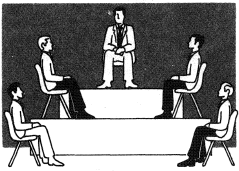Styles and Formats
In some types of production, scenery, lighting and camerawork make major contributions to the show’s success, in others, they play an unobtrusive supporting role. The balance can be a fine one.
Present a pianist in a fully lit area against a plain background, and the visual appeal on camera will be pretty low. But a superficial ‘imaginative’ presentation could be equally disastrous, with cameras continually moving around, lighting changing, superimpositions blending different viewpoints …One must take care that production treatment does not overwhelm performance.
Presentational emphasis
Let’s look at ways in which the emphasis can vary in typical productions:
• Demonstrations of all kinds, from cookery to auto-repairs, have common features. They use carefully controlled closeups, concentrate on detail, show the relationships between parts, compare differences in appearance. Speeded up or slowed down action may help to show developments more clearly.
• Spectacle can describe most large-area events from sports to orchestral concerts. These programs present their own particular quandary. When you show long shots of the overall activities, you may be missing interesting detail amongst individual performers. While you are showing closeups, important general action may be lost. Switch too early, and action hasn’t started. A moment too late, and it’s all over!
• Talk shows include interviews, discussions, and many game shows. Although shots are relatively static, the interplay between participants, and captured reaction shots, enliven the show’s spontaneous visual appeal.
• Drama presentations, which range from soap operas to Shakespeare, can explore all the sophistications of TV grammar—the subtle influences of camerawork, editing, lighting and sound. But one needs to avoid the temptation to overdramatize, and treat ‘ham’ as ‘Hamlet’.
• Composite presentations such as news programs (current affairs) and magazine programs intersperse studio material (e.g. a commentator or excperts) with inserts from videotape, film, graphics, slides, etc. They often rely on interlinking contributors from many different locations. In this kind of production, the director is preoccupied with precise cuing, accurate timings, and smooth continuity. So the actual presentation format is usually quite straight-forward.
• Compilation programs generally provide a summary or a survey of a subject. They are usually built up from a series of excerpts from library/stock sources (e.g. newsreels) which are blended together by an in-shot or voiceover commentator.
• Non-visual subjects (see ‘Visual padding’) are indeed a challenge to the director, who has to provide a flow of pictures which are apposite, neither too banal nor overfamiliar, neither too arresting nor too obscure. In most instances, the director resorts to brief library clips, and abstract effects.
Formal and dull
The symmetrical, balanced composition is dull and monotonous to the eye.

Posed shots
Composition has been carefully arranged here for dramatic effect. It could be mannered and too obviously arranged, or a powerful, naturally-evolved composition for the subject in hand.

Arranged display
The pattern the dancers make adds to the Yisyai appeal of the presentation.

Contrived pattern
The seated speakers, sitting in an identical pattern, look inappropriately arranged. The effect is awkward and strange.

